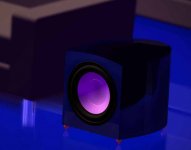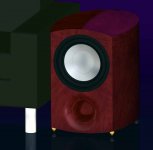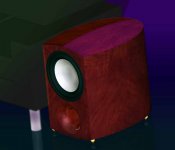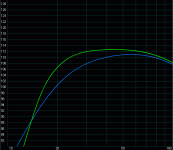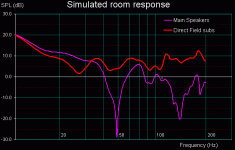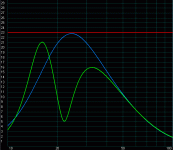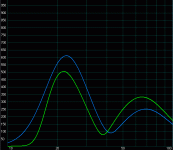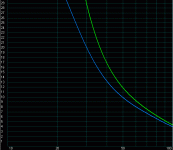My subs are currently in test boxes - 70L, one vented, the other sealed. I was going to go with a sealed box due to size issues, however, I have managed to sim a pretty good result for a 60L box, smaller than I thought feasible, and have managed to get it looking not too big.
Now I'm trying to decide on a small sealed 30L LT vs 60L vented, tuned @ 22 Hz. Both will be curved and I intend to place them either side of the couch, although I may at some point put them next to the mains, so they need to not be too large and chunky.
Now I'm trying to decide on a small sealed 30L LT vs 60L vented, tuned @ 22 Hz. Both will be curved and I intend to place them either side of the couch, although I may at some point put them next to the mains, so they need to not be too large and chunky.
Attachments
Now for some WinISD sims. The amp will be the Behringer Europower EP2500 which puts out 650w x 2 into 4 ohms. With a suitable rumble filter for each, the subs can take that much power within their excursion and thermal limits, but the vented sub gets as much as 6db more output with less excursion. The vented version actually requires less power, as shown byt the amplifier load chart and is likely to have lower distortion and be more linear. The main challenge is designing the vent. It's a 4" vent, the biggest I can manage, very generously flared on both ends with a 60mm flare radius.
Now for some charts ...
SPL
Now for some charts ...
SPL
Attachments
SPL shown for one sub so output will in fact be +6db + 4db room gain @20 Hz so there will be approx 118 db @ 20 Hz with the vented version. One thing I can't really allow for here is power compression. The sealed may not work as well as anticipated in sims as it uses more of the drivers excursion.
Now for room response. Note how the simulated response for the subs placed in the "direct field" either side of the couch is far smoother than that for the mains?
The response is pretty much flat +/- 3db, not bad really.
Now for room response. Note how the simulated response for the subs placed in the "direct field" either side of the couch is far smoother than that for the mains?
The response is pretty much flat +/- 3db, not bad really.
Attachments
Now for excursion. I keep telling myself "less is more" here, although I think I might miss the ability to get the cone moving 46 mm p-p with the vented version! It's not possible to bottom the driver or even get to xmax with the rumble filter included, which has been placed as low as possible to avoid rolloff.
Attachments
Group delay. This gets quite high down low due to the rumble filters used. Without these, the GD is much lower. I may in fact implement these as dynamic eq's with Ultracurve later so the performance may be better under normal use where the rumble filters are not needed.
Some issues I'm grappling with:
* is it worth having so much 20 Hz output?
The noise from all the room rattles at this point is more than the signal itself!
* is there really any audible difference between sealed and vented for music?
I think the differences are probably in favour of vented if both are done right.
* can I live with the bigger box?
* will vent noise be an issue? (don't have the amp yet to test properly)
All comments, suggestions, advice, challenges to the sims/ideas etc welcome
Some issues I'm grappling with:
* is it worth having so much 20 Hz output?
The noise from all the room rattles at this point is more than the signal itself!
* is there really any audible difference between sealed and vented for music?
I think the differences are probably in favour of vented if both are done right.
* can I live with the bigger box?
* will vent noise be an issue? (don't have the amp yet to test properly)
All comments, suggestions, advice, challenges to the sims/ideas etc welcome
Attachments
My sub is currently a 12 inch driver in a 60 litre box tuned to either 24 or 27 Hz (can't remember which now off the top of my head). I use a 100 mm vent. The driver is nothing fancy and is only about 120 W, 4 mm xmax. I designed it so that the limit is thermal, but only just.
There is significant (>12 dB) low boost and a 12 dB/oct Butterworth rumble filter just below the tuning frequency.
In my 17 x 12 ft room with 6 inch floorstanding loudspeakers, it plays to pretty loud levels with music (easy party levels), but runs out of excursion fairly easily on HT.
The box is fairly easy to accomodate but still the average person that visits thinks it's fairly big.
I'm upgrading to 2x 12 inch, quality, high power, long throw drivers in sealed 30 litre boxes with LT to 20 Hz. Amps will be ZAPpulse 2.2SE @ 400 W each. These will be placed either side of the sofa and be barely noticeable visually (one will be hidden under a coffee table).
I'm going to sealed because I think even with a flared 100 mm vent there will be too much wind with these high excursion drivers. It's undetectable at present with the cheap driver, but these new drivers have 4 times the excursion and putting your hand in front of the vent, there's a fair amount of movement as it is. Also, Rod Elliot seems to think that a vented box cannot pressurise a room properly and a sealed box has more impact.
I will be interested to see how you get on with this project -- I've been keeping an eye on your posts in general. I'll probably post some stuff when I get further on with mine.
I'll probably post some stuff when I get further on with mine.
There is significant (>12 dB) low boost and a 12 dB/oct Butterworth rumble filter just below the tuning frequency.
In my 17 x 12 ft room with 6 inch floorstanding loudspeakers, it plays to pretty loud levels with music (easy party levels), but runs out of excursion fairly easily on HT.
The box is fairly easy to accomodate but still the average person that visits thinks it's fairly big.
I'm upgrading to 2x 12 inch, quality, high power, long throw drivers in sealed 30 litre boxes with LT to 20 Hz. Amps will be ZAPpulse 2.2SE @ 400 W each. These will be placed either side of the sofa and be barely noticeable visually (one will be hidden under a coffee table).
I'm going to sealed because I think even with a flared 100 mm vent there will be too much wind with these high excursion drivers. It's undetectable at present with the cheap driver, but these new drivers have 4 times the excursion and putting your hand in front of the vent, there's a fair amount of movement as it is. Also, Rod Elliot seems to think that a vented box cannot pressurise a room properly and a sealed box has more impact.
I will be interested to see how you get on with this project -- I've been keeping an eye on your posts in general.
Love the style!
Frankly I like the woodgrain as opposed to black myself. Unfortunately, I'd say you know more than me as far as answering all the questions you posed. Is it worth it having 118 dB at 20Hz? I'm sure many people would think so, and is one reason the high excursion woofers from Adire and others have become so popular, along with super high output commercial units. For my own room, 110 dB is plenty, although at 20 Hz I'm closer to about 114 dB at max. But it's rare that I run the volume that high except to just 'wow' somebody. When the rattles in the room are actually louder than the signal at those kind of high output levels, I personally feel that 1. it's loud enough, or 2. you live in a lot of clutter.
I can't answer the vent noise question, as I'm using a relatively low excursion driver (would have been high 15 years ago!), and even with non-flared ports I have no noise. However, that's also because I am tuning to 11 Hz, where there is a lot less information than at 22 Hz. And further, it's my understanding that for equal sound pressure levels, when you lower the tuning frequency, port air speed goes down. This makes sense, because after all the port is resonating/moving air in and out at it's frequency. So, if you halve the frequency, you have half as much air moving back and forth, yes? Someone correct me if I'm wrong.
The group delay looks rather high to me, though whether it's audible is of course the question of the day. Many of us have heard the recommendations from Adire and True Audio (think that's the name), but lately the numbers seem to be creeping up. When I first started hearing Dan Wiggins talk about it, I seem to recall mention of 20 ms at 20 Hz. Now I'm hearing that anything under 30 ms is ok ? Of course it's easy to suggest that the lower it is, the better. Here's the problem as I see it: If you try to build two subwoofers to evaluate the effect of group delay, say the second having double the group delay of the first, you will end up with subwoofers having different frequency responses. And so how do you know that what you're hearing is the group delay, rather than the different response? If you model two subwoofers, one sealed and one vented, and adjust the parameters of the vented box such that it's frequency response curve matches that of the sealed, you'll see that the group delay is identical. Anyhow, I like to err on the side of caution, which is one reason I love to tune vented boxes very low. Group delay of my box is only 11 ms at 20 Hz, and from 30 Hz and up, mimics the group delay of a sealed box with a Qtc = 0.6. I cannot tell any difference in sound quality when I plug the ports, only extension. But, I have sacrificed a fair amount of power handling and maximum output capability. It's all compromise, isn't it.
Aaron Gilbert
Frankly I like the woodgrain as opposed to black myself. Unfortunately, I'd say you know more than me as far as answering all the questions you posed. Is it worth it having 118 dB at 20Hz? I'm sure many people would think so, and is one reason the high excursion woofers from Adire and others have become so popular, along with super high output commercial units. For my own room, 110 dB is plenty, although at 20 Hz I'm closer to about 114 dB at max. But it's rare that I run the volume that high except to just 'wow' somebody. When the rattles in the room are actually louder than the signal at those kind of high output levels, I personally feel that 1. it's loud enough, or 2. you live in a lot of clutter.
I can't answer the vent noise question, as I'm using a relatively low excursion driver (would have been high 15 years ago!), and even with non-flared ports I have no noise. However, that's also because I am tuning to 11 Hz, where there is a lot less information than at 22 Hz. And further, it's my understanding that for equal sound pressure levels, when you lower the tuning frequency, port air speed goes down. This makes sense, because after all the port is resonating/moving air in and out at it's frequency. So, if you halve the frequency, you have half as much air moving back and forth, yes? Someone correct me if I'm wrong.
The group delay looks rather high to me, though whether it's audible is of course the question of the day. Many of us have heard the recommendations from Adire and True Audio (think that's the name), but lately the numbers seem to be creeping up. When I first started hearing Dan Wiggins talk about it, I seem to recall mention of 20 ms at 20 Hz. Now I'm hearing that anything under 30 ms is ok ? Of course it's easy to suggest that the lower it is, the better. Here's the problem as I see it: If you try to build two subwoofers to evaluate the effect of group delay, say the second having double the group delay of the first, you will end up with subwoofers having different frequency responses. And so how do you know that what you're hearing is the group delay, rather than the different response? If you model two subwoofers, one sealed and one vented, and adjust the parameters of the vented box such that it's frequency response curve matches that of the sealed, you'll see that the group delay is identical. Anyhow, I like to err on the side of caution, which is one reason I love to tune vented boxes very low. Group delay of my box is only 11 ms at 20 Hz, and from 30 Hz and up, mimics the group delay of a sealed box with a Qtc = 0.6. I cannot tell any difference in sound quality when I plug the ports, only extension. But, I have sacrificed a fair amount of power handling and maximum output capability. It's all compromise, isn't it.
Aaron Gilbert
I have heard Rod Elliotts commments on sealed subs regarding pressurising the room. It's the one thing he says that appears to contradict what you can measure. I can't yet relate it to my own experience. Yesterday I was watching parts of Matrix reloaded, which I think has a lot of LFE signals. I like the effect you get with machine guns when there is a very deep hard to describe sound when the machine gun loads a cartridge. Subjectively it seems to go down very low and when I heard it on a system with a vented tumult, it had something every other system lacked in depth and power.
I have noticed that bass seems to escape out of the room a lot more when windows are open. I stand at the back of the room for a "bass fix" only to find the usual output there is all but gone literally out the window!
I'm now at the point where I consider vented subs to be superior to sealed in performance. While it is probably true that bass from the driver alone is more accurate, the vent is in use in the LFE range, where the driver needs all the help it can get.
Aaron, I had a feeling that someone would like woodgrain more! I find black isn't so fussy about the room visually. Put natural timber speakers into a room with timber floors, timber furniture and suddenly you have an uphill battle to match it all. I like dark red stains in timber and exotic patterns, but they often mean difficult to work veneer (which I've come to grief with my mains), and also it limits choices in things you place in the room, and the colour scheme, since in my case, the speakers come before the room. There's no doubt, however, that some solid timber with a carved out look could be impressive.
Re rattles ... there isn't THAT much in the room, although if it were up to me I'd turf a lot of stuff in the room. It's pictures on the wall that rattle, even on the other side of the wall. Also windows, the lock on the double doors to the room ... everything! :O
Maybe the only room that can handle these subs is a bomb shelter! (unless it can keep a bomb out, it can't keep these subs in
I have noticed that bass seems to escape out of the room a lot more when windows are open. I stand at the back of the room for a "bass fix" only to find the usual output there is all but gone literally out the window!
I'm now at the point where I consider vented subs to be superior to sealed in performance. While it is probably true that bass from the driver alone is more accurate, the vent is in use in the LFE range, where the driver needs all the help it can get.
Aaron, I had a feeling that someone would like woodgrain more! I find black isn't so fussy about the room visually. Put natural timber speakers into a room with timber floors, timber furniture and suddenly you have an uphill battle to match it all. I like dark red stains in timber and exotic patterns, but they often mean difficult to work veneer (which I've come to grief with my mains), and also it limits choices in things you place in the room, and the colour scheme, since in my case, the speakers come before the room. There's no doubt, however, that some solid timber with a carved out look could be impressive.
Re rattles ... there isn't THAT much in the room, although if it were up to me I'd turf a lot of stuff in the room. It's pictures on the wall that rattle, even on the other side of the wall. Also windows, the lock on the double doors to the room ... everything! :O
Maybe the only room that can handle these subs is a bomb shelter! (unless it can keep a bomb out, it can't keep these subs in

One thing I need to resolve is vent noise. How much vent velocity is acceptable? I have heard 5% of the speed of sound ~ 17m/s, however this is not allowing for flares on both ends. To get vent velocity this low I need a 150mm diam vent, which would have to be 1.6m long! (not practical) It would also resonate at 100 Hz, a little too close!
Supposing with the flares it was acceptable to get 10% of the speed of sound due to larger flare radius (60mm) >>> this is not so hard to accomodate. The vent I have in mind (100mm diam) almost does it, peaking at 38m/s vent air velocity.
Is this going to be acceptable?
I could possibly look at using a 120mm vent which then lowers the vent velocity to 26 m/s which is 7.5% of the speed of sound. The vent then becomes 1m long unless I compromise a little on the tuning and tune it at 23 or 24 Hz getting it down to 880mm long.
Can the section of the vent that is flared be included as making up the required length? Or does this have to be added on? eg supposing 1m vent is required and the flare radius is 60mm on each end. Should the total vent length be 1000mm or 1120mm?
Supposing with the flares it was acceptable to get 10% of the speed of sound due to larger flare radius (60mm) >>> this is not so hard to accomodate. The vent I have in mind (100mm diam) almost does it, peaking at 38m/s vent air velocity.
Is this going to be acceptable?
I could possibly look at using a 120mm vent which then lowers the vent velocity to 26 m/s which is 7.5% of the speed of sound. The vent then becomes 1m long unless I compromise a little on the tuning and tune it at 23 or 24 Hz getting it down to 880mm long.
Can the section of the vent that is flared be included as making up the required length? Or does this have to be added on? eg supposing 1m vent is required and the flare radius is 60mm on each end. Should the total vent length be 1000mm or 1120mm?
I am leaning more towards your feelings on the sound/impact of vented vs. sealed than Rod's. You have to compare like for like and I can't help thinking that maybe the sealed system Rod thought pressurised the room better simply had lower F3 and/or shallower roll-off than what he was used to.
I'm still sticking with sealed though because even with a 60 litre box and 100 mm vent tuned not even to 20 Hz, accomodating it was difficult. And I'm convinced 100 mm is too small a vent for a high excursion 12 inch driver. Maybe before I write that off I will put my high excursion driver in my existing box and see what noises I get. I still want a smaller box though so that precludes vented anyway.
I'm also a bit weary about HT use and placing by the sofa. I'm quite concerned that the sound will be able to be localised. The answer would be to route the LFE channel to front left and right and drive from the mains with a filter, but this may reduce the impact and/or change the sound too much and/or strain my mains and/or be difficult to tune/balance. If I find that I have to keep the subs near the mains, this will be near enough impossible with 60 litre boxes for me.
As for the vent length with a flare, I think it's a bit of trial and error. I suppose you could speculate that depending on the radius, the length required could begin from the midpoint of the flare.
I'm still sticking with sealed though because even with a 60 litre box and 100 mm vent tuned not even to 20 Hz, accomodating it was difficult. And I'm convinced 100 mm is too small a vent for a high excursion 12 inch driver. Maybe before I write that off I will put my high excursion driver in my existing box and see what noises I get. I still want a smaller box though so that precludes vented anyway.
I'm also a bit weary about HT use and placing by the sofa. I'm quite concerned that the sound will be able to be localised. The answer would be to route the LFE channel to front left and right and drive from the mains with a filter, but this may reduce the impact and/or change the sound too much and/or strain my mains and/or be difficult to tune/balance. If I find that I have to keep the subs near the mains, this will be near enough impossible with 60 litre boxes for me.
As for the vent length with a flare, I think it's a bit of trial and error. I suppose you could speculate that depending on the radius, the length required could begin from the midpoint of the flare.
One thing I know is that the effective length of a vent is less than the physical length. There are end correction factors, depending on how the vent is terminated. What I don't know is if the correction factor is added to the straight section of the vent or the end of the flare ... does anyone know?
Flares and length.
It's always been my understanding that the length of the flare(s) is included in the total length of the vent. So for example, for the Precision Port flared vents, with no center section whatsoever, the shortest vent length is 5.75" for the 3" diameter vent. I believe Adire mentions this in one of their tech papers, or it could be in one of the Shiva/Tempest/etc. application notes.
Aaron Gilbert
It's always been my understanding that the length of the flare(s) is included in the total length of the vent. So for example, for the Precision Port flared vents, with no center section whatsoever, the shortest vent length is 5.75" for the 3" diameter vent. I believe Adire mentions this in one of their tech papers, or it could be in one of the Shiva/Tempest/etc. application notes.
Aaron Gilbert
Don't know if you're reading this correctly.
Simon,
The adjustment in overall port length for a flared port is minimal. If your subwoofer needs a 12" long port, then for a flared Precision Port (which is what Adire uses), you'd cut the center section to about 7" long, thus adding the 5" combined length of the flares to get your 12" total. Check this page for more information:
http://www.psp-inc.com/psp-inc.com/public_html/manual.htm
It appears that when done this way, the total length comes out to 1" longer than the 5" + center section length, which indicates to me they have assumed some end correction which requires the extra length.
Aaron Gilbert
Simon,
The adjustment in overall port length for a flared port is minimal. If your subwoofer needs a 12" long port, then for a flared Precision Port (which is what Adire uses), you'd cut the center section to about 7" long, thus adding the 5" combined length of the flares to get your 12" total. Check this page for more information:
http://www.psp-inc.com/psp-inc.com/public_html/manual.htm
It appears that when done this way, the total length comes out to 1" longer than the 5" + center section length, which indicates to me they have assumed some end correction which requires the extra length.
Aaron Gilbert
The precision port site makes sense. The effective length of the vent is shorter than its physical length to the outside of the flare. With precision ports it is 1/2" less for each flare. My flares have a bigger radius, so this will be more. Precision ports have a flare radius of 1"
So from this I assume that you may take half of the flare radius as useable. Hence if the straight section is 720mm long then the effective length of a vent with a 60mm flare radius is 720 + 30x2 mm >>> 780mm, while the physical length is 840mm.
So from this I assume that you may take half of the flare radius as useable. Hence if the straight section is 720mm long then the effective length of a vent with a 60mm flare radius is 720 + 30x2 mm >>> 780mm, while the physical length is 840mm.
Hi Paul.
My 2226 doesnt reach to 22hz so I cant quite relate to what your experience is,nor do I use mine for HT.
But what I can say,is that if i could afford it,I would use either sealed or horn for subwoofer duty. I use my subwoofer, at the middle of the end of a long rectangular room approx 2x as long as it is wide, with high ceilings about 2.6metres high. Windows/curtains behind mainspeakers/ sub.
Ofcourse,low distortion units with shorting rings and SFG with sealed box specs arent available!
The 500L horn will have to do! Im not sure where il put it yet,it might have to go elsewhere in the room-Im trying to find a digital delay chip which i can use to delay my mains! I probably wont mind 20ms delay because its a crappy main speaker system,but still!
My 2226 doesnt reach to 22hz so I cant quite relate to what your experience is,nor do I use mine for HT.
But what I can say,is that if i could afford it,I would use either sealed or horn for subwoofer duty. I use my subwoofer, at the middle of the end of a long rectangular room approx 2x as long as it is wide, with high ceilings about 2.6metres high. Windows/curtains behind mainspeakers/ sub.
Ofcourse,low distortion units with shorting rings and SFG with sealed box specs arent available!

The 500L horn will have to do! Im not sure where il put it yet,it might have to go elsewhere in the room-Im trying to find a digital delay chip which i can use to delay my mains! I probably wont mind 20ms delay because its a crappy main speaker system,but still!

- Status
- This old topic is closed. If you want to reopen this topic, contact a moderator using the "Report Post" button.
- Home
- Loudspeakers
- Subwoofers
- Considering sealed vs vented for my AV12 subs
